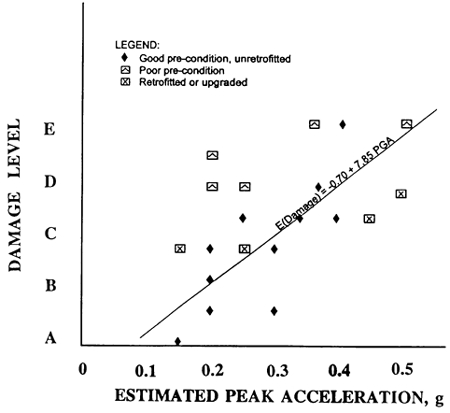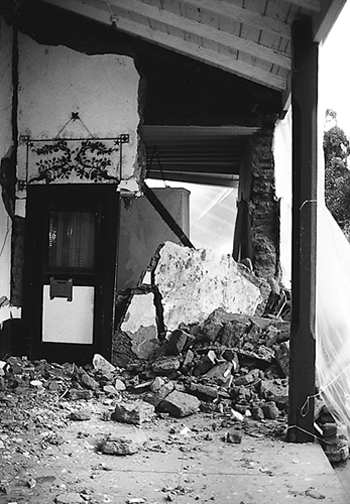SEISMIC STABILIZATION OF HISTORIC ADOBE STRUCTURESWILLIAM S. GINELL, & E. LEROY TOLLES
10 10. NORTHRIDGE EARTHQUAKEThe occurrence of the Northridge earthquake in January 1994 in California provided a unique opportunity to compare the actual damage sustained by existing, real adobe structures with the damage observed during the model adobe building shaking table tests. Shortly after the earthquake, a survey of 19 historic adobe buildings located in Los Angeles and Ventura Counties was conducted by a team consisting of two engineers, an architect, and an architectural historian. The intent of the survey was to document the damage to the buildings, correlate the damage with measured ground movements and building condition, and provide information to owners, building officials, cultural resource managers, architects, and engineers that would assist in the understanding of seismic threats to such structures. Based on the information generated during the survey (Tolles et al. 1996), estimates were made regarding expected damage to historic adobe buildings as a function of estimated peak ground acceleration. For well-maintained historic adobes, figure 10 shows the relationship between acceleration and damage. Ground acceleration in the range of 0.1 to 0.2 g seems to be required to initiate damage in such adobe buildings. At this level of ground motion, cracks begin to form at door and window openings and at the intersections of perpendicular walls. At the historic adobe building sites studied where the acceleration was in this range, one was undamaged, two suffered slight damage, while another suffered slight to moderate damage. These adobes had been well maintained and had not been reinforced or retrofitted. At acceleration levels of about 0.4 g, the damage was found to be more extensive throughout the structure.
Pre-existing conditions greatly affected the observed damage level. In figure 10, all data on buildings with pre-existing water and earthquake damage were found above the expected damage line for well-maintained adobes, indicating that severe damage can be expected for buildings in poor condition. Even for ground motions of moderate intensity (0.1 to 0.2 g), poorly maintained buildings are likely to suffer substantial damage. Comparison of laboratory tests and field observations show good correlation, and the important observations can be summarized as follows:
These observations are valid for typical historic adobe buildings that had been well maintained, had moderately thick or thick walls, and adobe of average strength. The presence of higher-strength adobe material may delay the onset of cracking. Low-strength adobe or previously damaged walls will have a negative impact on the performance, and thinner walls will be more likely to collapse. Many of the damage typologies observed in the field after the Northridge earthquake were also observed in the 1:5 scale model buildings. The typical out-of-plane wall failures were observed in numerous historic adobe buildings, and the crack patterns resulting from out-of-plane flexural failure and gable end failure were also typical failure patterns observed in the field and in the laboratory. The out-of-plane collapse of load-bearing walls was observed at only one site (fig. 11). However, this failure was not the result of overturning but was caused by moisture damage at the base of the wall, which is yet a different, but important, failure mode.
At corners, vertical and diagonal cracks in the models were observed and were similar to those observed in the field, but in-plane shear cracks occurred less frequently. Mechanical tests of the 1:5 scale adobe brick assemblies showed that the shear strength was proportionately higher compared to the compressive or flexural strengths. Therefore, in-plane shear cracks are less likely to occur than vertical or diagonal cracks. In general, the overall crack patterns observed in the model buildings were similar to those found in historic adobe buildings after the Northridge earthquake. The nature of the postelastic behavior is largely dependent upon location of the crack patterns and the resulting movement of the cracked wall sections. The dynamic motions of the models would then be expected to be similar to those found in the field. |

